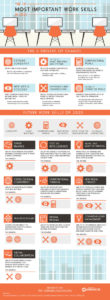[Editor’s note: This story, originally published on June 20th of this year, was our #1 most popular story of the year. Happy holidays, and thank you for tuning into our 2017 countdown!]
Today’s workforce, as nearly everyone knows, is increasingly global. And with that global nature comes fierce competition–students will need an arsenal of workforce skills in order to stand out from their peers.
According to a recent McGraw-Hill Education survey, just 40 percent of college seniors said they felt their college experience was helpful in preparing for a career. Alarmingly, that percentage plummeted to 19 percent for women answering the same question.
That same survey also found that students in STEM majors were the most likely out of any group to report that they are optimistic about their career prospects (73 percent).
According to data from the nonprofit Institute for the Future, there are 6 drivers of change in today’s workforce:
1. Extreme longevity: People are living longer–by 2025 the number of Americans older than 60 will increase by 70 percent
2. The rise of smart machines and systems: Technology can augment and extend our own capabilities, and workplace automation is killing repetitive jobs
3. Computational world: Increases in sensors and processing makes the world a programmable system; data will give us the ability to see things on a scale that has never been possible
4. New media ecology: New communication tools require media literacies beyond text; visual communication media is becoming a new vernacular
5. Superstructured organizations: Social technologies drive new forms of production and value creation, and social tools are allowing organizations to work at extreme scales
6. Globally connected world: Diversity and adaptability are at the center of operations–the U.S. and Europe no longer hold a monopoly on job creation, innovation, and political power
(Next page: An infographic illustrates today’s in-demand workforce skills)
These 6 drivers are leading employers to seek out new and unique skills–skills that are quickly becoming some of the most in-demand in the workforce.
The top 10 workforce skills of 2020 include:
1. Sense making: The ability to determine the deeper meaning or significance of what is being expressed. The Drivers: Rise of smart machines and systems
2. Social intelligence: The ability to connect to others in a deep and direct way, to sense and stimulate reactions and desired interactions. The Drivers: Rise of smart machines and systems, globally connected world
3. Novel and adaptive thinking: Proficiency at thinking and coming up with solutions and responses beyond that which is rote or rule-based. The Drivers: Rise of smart machines and systems, globally connected world
4. Cross cultural competency: The ability to operate in different cultural settings. The Drivers: Superstructured organizations, globally connected world
5. Computational thinking: The ability to translate vast amounts of data into abstract concepts and to understand data based reasoning. The Drivers: New media ecology, computational world
6. New media literacy: The ability to critically assess and develop content that uses new media forms, and to leverage these media for persuasive communication. The Drivers: Extreme longevity, new media ecology, Superstructured organizations
7. Transdisciplinary: Literacy in and ability to understand concepts across multiple disciplines. The Drivers: Extreme longevity, computational world
8. Design mindset: The ability to represent and develop tasks and work processes for desired outcomes. The Drivers: Superstructured organizations, computational world
9. Cognitive load management: The ability to discriminate and filter information for importance, and to understand how to maximize cognitive functions. The Drivers: Superstructured organizations, computational world, new media ecology
10. Virtual collaboration: The ability to work productively, drive engagement, and demonstrate presence as a member of a virtual team. The Drivers: Superstructured organizations, globally connected world
Click on the infographic below for a larger view:
- Report forecasts a ‘surge’ in GenAI adoption - April 26, 2024
- Where are microcredentials today–and where are they going? - April 22, 2024
- First-generation students are more likely to seriously consider leaving college - April 17, 2024


